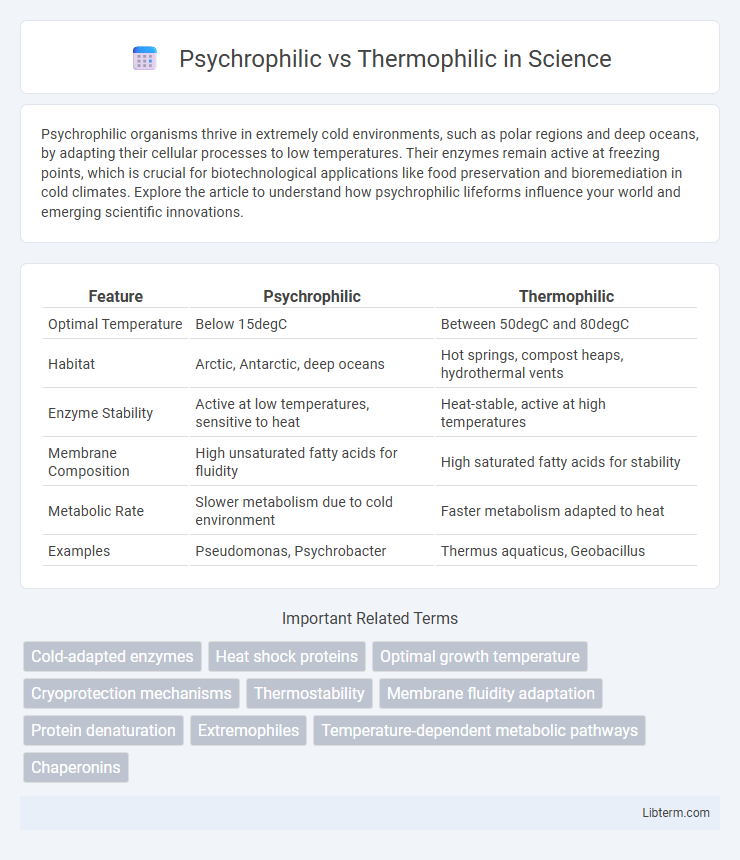Psychrophilic organisms thrive in extremely cold environments, such as polar regions and deep oceans, by adapting their cellular processes to low temperatures. Their enzymes remain active at freezing points, which is crucial for biotechnological applications like food preservation and bioremediation in cold climates. Explore the article to understand how psychrophilic lifeforms influence your world and emerging scientific innovations.
Table of Comparison
| Feature | Psychrophilic | Thermophilic |
|---|---|---|
| Optimal Temperature | Below 15degC | Between 50degC and 80degC |
| Habitat | Arctic, Antarctic, deep oceans | Hot springs, compost heaps, hydrothermal vents |
| Enzyme Stability | Active at low temperatures, sensitive to heat | Heat-stable, active at high temperatures |
| Membrane Composition | High unsaturated fatty acids for fluidity | High saturated fatty acids for stability |
| Metabolic Rate | Slower metabolism due to cold environment | Faster metabolism adapted to heat |
| Examples | Pseudomonas, Psychrobacter | Thermus aquaticus, Geobacillus |
Introduction to Psychrophilic and Thermophilic Organisms
Psychrophilic organisms thrive in extremely cold environments, typically below 15degC, exhibiting specialized enzymes and cellular structures adapted to maintain metabolic activity at low temperatures. Thermophilic organisms, on the other hand, flourish in high-temperature habitats above 45degC, with proteins and membranes that remain stable and functional under heat stress. These adaptations enable psychrophiles and thermophiles to colonize diverse niches ranging from polar ice caps to hot springs, playing critical roles in biogeochemical cycles.
Defining Psychrophiles: Life in the Cold
Psychrophiles are microorganisms adapted to thrive in extremely cold environments, typically thriving at temperatures below 15degC and capable of growth at or below 0degC. These cold-loving organisms possess specialized enzymes and membrane structures that maintain cellular function and stability in subzero conditions, making them essential for nutrient cycling in polar regions and deep ocean habitats. Unlike thermophiles, which flourish in heat above 45degC, psychrophiles optimize metabolic processes to survive in icy ecosystems, highlighting their unique ecological roles in cold climate biology.
Thermophiles: Thriving in Extreme Heat
Thermophiles are microorganisms that thrive at temperatures between 45degC and 122degC, predominantly found in environments like hot springs, hydrothermal vents, and geothermal soils. Their enzymes, such as Taq polymerase, are heat-stable and widely used in industrial processes and molecular biology applications like PCR. Unlike psychrophiles, which adapt to cold temperatures, thermophiles possess specialized proteins and membrane structures enabling survival and metabolic activity under extreme heat.
Habitat and Environmental Distribution
Psychrophilic organisms thrive in cold environments such as polar regions, deep ocean waters, and alpine habitats, where temperatures typically range from -20degC to 10degC. Thermophilic organisms inhabit hot environments including geothermal springs, hydrothermal vents, and compost piles, with optimal growth temperatures between 45degC and 80degC. The distinct environmental distribution reflects their adaptations to extreme temperature ranges, influencing their metabolic processes and ecological niches.
Cellular Adaptations for Temperature Extremes
Psychrophilic organisms exhibit cellular adaptations such as increased membrane fluidity through unsaturated fatty acids and production of cold-active enzymes with flexible structures, ensuring metabolic functionality at low temperatures. Thermophilic organisms stabilize their cellular components with saturated fatty acids, heat-shock proteins, and thermostable enzymes containing increased ionic bonds and hydrophobic cores, enabling survival under extreme heat. Both adaptations involve modifications to membrane composition, enzyme kinetics, and protein folding mechanisms tailored to optimize cellular processes at temperature extremes.
Enzymatic Differences between Psychrophiles and Thermophiles
Psychrophilic enzymes function efficiently at low temperatures due to increased structural flexibility and reduced activation energy, enabling catalytic activity near freezing points. Thermophilic enzymes exhibit enhanced thermal stability through rigid structures, increased hydrogen bonding, and hydrophobic cores, maintaining activity at temperatures above 60degC. These enzymatic adaptations reflect evolutionary divergence optimizing biocatalysis according to environmental thermal conditions.
Genetic Mechanisms of Temperature Tolerance
Psychrophilic organisms possess specialized genes encoding cold-active enzymes and membrane proteins with increased flexibility, enabling cellular processes at low temperatures. Thermophilic species exhibit genetic adaptations like heat-stable chaperones, thermostable DNA polymerases, and enhanced protein folding mechanisms to maintain functionality at elevated temperatures. Comparative genomic studies reveal distinct regulatory networks controlling stress response genes, optimizing survival across extreme thermal environments.
Industrial and Biotechnological Applications
Psychrophilic microorganisms thrive in cold environments and are utilized in industrial processes such as bioremediation in cold regions and cold-active enzyme production for detergents and food processing, enabling energy-efficient reactions at low temperatures. Thermophilic microbes, adapted to high temperatures, are critical in biotechnological applications like biofuel production, waste treatment, and the synthesis of thermostable enzymes used in PCR, paper manufacturing, and pharmaceuticals, offering enhanced stability and reaction rates. The distinct thermal adaptations of psychrophiles and thermophiles provide versatile solutions for optimizing industrial bioprocesses under extreme temperature conditions.
Ecological Impact and Importance
Psychrophilic organisms thrive in cold environments such as polar regions and deep oceans, playing crucial roles in nutrient cycling and organic matter decomposition under low-temperature conditions, which supports cold ecosystem stability. Thermophilic organisms inhabit hot environments like geothermal springs and compost heaps, where they accelerate the breakdown of organic material and contribute to energy flow in extreme temperatures. Both psychrophiles and thermophiles are essential in biotechnological applications, including bioremediation and industrial processes, due to their unique enzymatic adaptations to extreme thermal conditions.
Future Research and Potential Discoveries
Future research on psychrophilic and thermophilic microorganisms is expected to uncover novel enzymes and metabolic pathways that enable survival in extreme temperatures, offering advancements in biotechnology and industrial applications. Investigating genetic adaptations in these extremophiles could lead to the development of new bioengineering techniques for enhanced enzyme stability and efficiency under harsh thermal conditions. Potential discoveries may revolutionize sustainable bioprocesses, environmental remediation, and the synthesis of temperature-resistant biomaterials.
Psychrophilic Infographic

 libterm.com
libterm.com